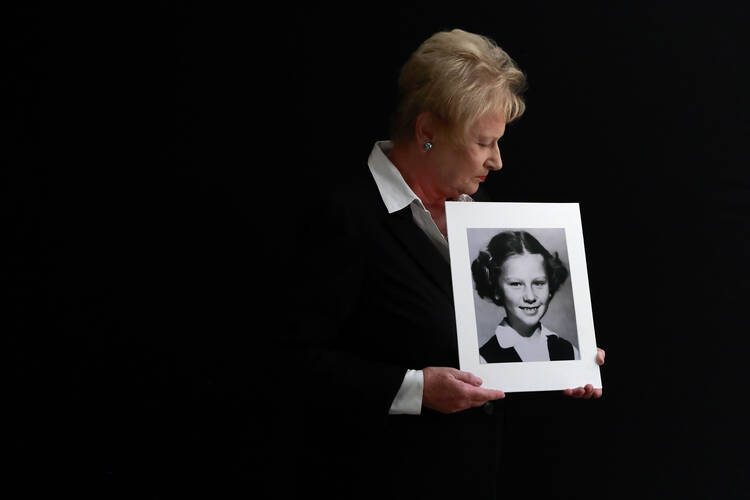NEW YORK (AP) — A wave of new laws in 15 states that allow people to make claims of sexual abuse going back decades could bring a deluge of lawsuits against the Roman Catholic Church that could surpass anything seen so far in its clergy abuse crisis.
Associated Press reporting found it could result in thousands of new cases against the church and more than $4 billion in payouts.
It's a financial reckoning playing out in such populous Catholic strongholds as New York, California and New Jersey, among the eight states that go the furthest with "lookback windows" that allow sex abuse claims no matter how old.
That has lawyers fighting for clients with TV ads and billboards asking, "Were you abused by the church?" And Catholic dioceses are considering bankruptcy, victim compensation funds and even tapping valuable real estate to stay afloat.
"It's like a whole new beginning for me," said 71-year-old Nancy Holling-Lonnecker of San Diego, who plans to take advantage of an upcoming three-year window for such suits in California. Her claim dates back to the 1950s, when she says a priest repeatedly raped her in a confession booth beginning when she was 7 years old.
"The survivors coming forward now have been holding on to this horrific experience all of their lives," she said. "They bottled up those emotions all of these years because there was no place to take it."
AP interviews with more than a dozen lawyers and clergy abuse watchdog groups offered a wide range of estimates but many said they expected at least 5,000 new cases against the church in New York, New Jersey and California alone, resulting in potential payouts that could surpass the $4 billion paid out since the clergy sex abuse first came to light in the 1980s.
Some lawyers believe payouts could be heavily influenced by the recent reawakening over sexual abuse fueled by the #MeToo movement, the public shaming of accused celebrities and the explosive Pennsylvania grand jury report last year that found 300 priests abused more than 1,000 children in that state over seven decades.
"The general public is more disgusted than ever with the clergy sex abuse and the cover-up, and that will be reflected in jury verdicts," said Mitchell Garabedian, a Boston attorney who was at the center of numerous lawsuits against the church in that city and was portrayed in the movie "Spotlight."
Since the 15 states changed their laws within the past two years, the onslaught of lawsuits is coming in waves.
This summer, when New York state opened its one-year window allowing sexual abuse suits with no statute of limitations, more than 400 cases against the church and other institutions were filed on the first day alone. That number is now up to more than 1,000, with most against the church. New Jersey's two-year window opens this week and California's three-year window begins in the new year, with a new provision that allows plaintiffs to collect triple damages if a demonstrable cover-up can be shown. Arizona, Montana and Vermont opened ones earlier this year.
Already, longtime clergy abuse lawyer Michael Pfau in Seattle says he's signed up about 800 clients in New York, New Jersey and California. Boston's Garabedian says he expects to file 225 in New York, plus at least 200 in a half-dozen other states. Another veteran abuse litigator, James Marsh, says he's collected more than 200 clients in New York alone.
"A trickle becomes a stream becomes a flood," Marsh said.
Church leaders who had for years lobbied statehouses against loosening statute-of-limitations laws say this is exactly the kind of feeding frenzy they were worried about. And some have bemoaned the difficulty of trying to counter accusations of abuse that happened so long ago that most witnesses have scattered and many of the accused priests are long dead.
"Dead people can't defend themselves," said Mark Chopko, former general counsel to the U.S. Conference of Catholic Bishops.
The church's response weighs heavily on compensation funds and bankruptcy.
New York Archbishop Timothy Dolan set up the first fund in 2016, pitching it as a way to compensate victims without walloping the church and forcing it to cut programs. It has since paid more than $67 million to 338 alleged victims, an average $200,000 each.
The idea has caught on in other states. All five dioceses in New Jersey and three in Colorado opened one, as did seven dioceses in Pennsylvania and six in California, including the Archdiocese of Los Angeles, the largest in the U.S.
More drastic and increasingly more common is the bankruptcy option. Less than a month after New York's one-year lookback window took effect, the upstate Diocese of Rochester filed for bankruptcy, the 20th diocese or religious order in the country to do so.
When a diocese files for bankruptcy, lawsuits by alleged abuse survivors are suspended and payments to them and others owed money are frozen while a federal judge decides how much to pay everyone and still leave enough for the diocese to continue to operate. It's orderly and victims avoid costly and lengthy court cases, but they often get less than they would if they were successful in a trial.
Bankruptcy can also leave abuse survivors with a sense of justice denied because the church never has to face discovery by plaintiff lawyers and forced to hand over documents, possibly implicating higher-ups who hid the abuse.
For many of his clients, New York lawyer Adam Slater said, that step is crucial.
"They want to see how the church allowed them to be abused, how they ruined their lives," he said. "It's a different process in bankruptcy — you don't get discovery and you don't get it in compensation programs. The truth never comes to light."









